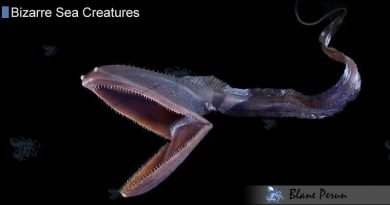Mariana Snailfish
The Mariana snailfish (Pseudoliparis swirei) is a creature living in the deepest spot on Earth, the hadal zone of the Mariana Trench in the Pacific Ocean (the term hadal comes from Hades, the underworld in Greek mythology). The animal’s known depth range is between 6,198 m and almost 8,100 meters, being the deepest-living fish on our planet.
The body of the Mariana snailfish is shaped and constructed to meet the special challenges bought by the extreme environment that it thrives in. The body is shaped like a tadpole and it is of a pale pink color. The standard length of observed individuals is around 29 cm, with a weight of up to 160 g. Their body is scaleless, with a single dorsal fin. This special, very hardy snailfish is one of the top predators of the area, its diet consists mainly of tiny crustaceans. The Mariana snailfish has adapted to the frigid temperatures and crushing pressures of its deep-sea environment, enhancing its ability to thrive where few other species can. This unique predator exhibits a fascinating behavior typical to its armored snail habitat and behavior, utilizing stealth to ambush its prey among the complex structures of the ocean floor. Additionally, its lack of a swim bladder allows it to navigate effortlessly throughout the water column, further asserting its dominance in this extreme aquatic ecosystem.
The critter was first seen in 2014, by a research vessel that went deep down into the trench, sampling the water and recording related data. After the first individual was captured, another 35 of them were caught over the next 10 days, then the species was lost site of for a couple years, to reappear on another underwater vehicle’s screen in 2017. These sightings sparked renewed interest in studying these bizarre creatures of the ocean, leading to extensive research on their habitat and behavior. Scientists are particularly fascinated by their adaptations to extreme depths and the unique ecosystems they inhabit. As exploration technology advances, the hope is to uncover more about these elusive beings and the role they play in the marine environment.
The animal was named this way as a tribute Herbert Swire, who circumnavigated the globe between 1872-1876 and who participated in the expedition that discovered the spot in the Trench where the Mariana snailfish lives, a depression called the Challenger Deep.
Exploring the Depths: The Mariana Snailfish’s Secretive Life
Introduction The Mariana Trench, Earth’s deepest chasm, harbors a multitude of enigmas, among which the Mariana Snailfish (Pseudoliparis swirei) reigns supreme. This article delves into the mysterious life of the Mariana Snailfish, a creature that thrives where pressure overwhelms most life forms. Adapted to extreme conditions, the Mariana Snailfish showcases remarkable biological adaptations that enable it to flourish in such a hostile environment. Scientists have also drawn intriguing comparisons to other deep-sea organisms, examining halitrephes maasi species details to further understand the evolutionary strategies employed by life in the abyss. The resilience of these unique creatures not only fascinates researchers but also sheds light on the adaptability of life on our planet.
The Mystique of Mariana Trench Inhabitants At the hadal depths, light doesn’t penetrate, and the pressure is crushing. Yet, the Mariana Snailfish flourishes at depths exceeding 8,000 meters. Scientists speculate that its gelatinous structure, lacking in heavy skeletal features, enables it to withstand such extreme conditions.
Anatomy of Survival Remarkably adapted to its environment, the Mariana Snailfish has a unique physiology. Its body, translucent and scaleless, reveals a complex internal structure fine-tuned for deep-sea survival. The absence of swim bladders, replaced by a high concentration of trimethylamine oxide, prevents the fish from succumbing to the surrounding pressure.
Diet and Sustenance Feeding in the abyss, the snailfish preys on small invertebrates like amphipods. Its diet is a testament to the complex food chain existing even in the deepest parts of the ocean. Through opportunistic feeding, the Mariana Snailfish plays a crucial role in the hadal ecosystem. In addition to its role as a predator, the snailfish also benefits from the unique habitat provided by various deep-sea organisms. Among these, the carnivorous harp sponge features an intricate structure that aids in trapping small prey, contributing to the diverse interactions within this isolated environment. This interconnectedness highlights the intricate balance of life that thrives under extreme conditions, showcasing how even the smallest species have significant impacts on their surroundings.
Reproduction and Life Cycle The breeding habits of the Mariana Snailfish remain largely a mystery. However, evidence suggests that they lay eggs in the protective shelter of the trench’s nooks, ensuring a safe environment for the next generation.
Adaptations and Evolutionary Marvels The evolution of the Mariana Snailfish is a narrative of resilience. Its body produces unique enzymes and structural proteins that prevent cellular collapse under extreme pressure, making it a subject of great interest for biotechnological applications.
Threats and Conservation Efforts Human activities, even those in remote locations, pose a threat to the Mariana Snailfish. Pollution and deep-sea mining can disrupt its habitat. Conservation efforts focus on research and potential regulations to protect these depths from exploitation. Understanding the Mariana Snailfish’s ecology is crucial for conservation, particularly in relation to the sea fleas habitat and behavior that coexists in the same environment. Research is ongoing to establish how these organisms interact and how changes in their habitat could affect their survival. By safeguarding the intricate relationships within this ecosystem, we can better ensure the resilience of the Mariana Snailfish and its fellow deep-sea inhabitants.
FAQs
- What enables the Mariana Snailfish to survive at extreme depths?
- How does the Mariana Snailfish contribute to its ecosystem?
- What are the reproductive habits of the Mariana Snailfish?
- Why is the Mariana Snailfish important for scientific research?
- How can we protect the Mariana Snailfish from human-related threats?
Conclusion The Mariana Snailfish, a symbol of nature’s adaptability, continues to intrigue and inspire. As stewards of the oceanic frontiers, it is our responsibility to ensure that its home remains undisturbed.




